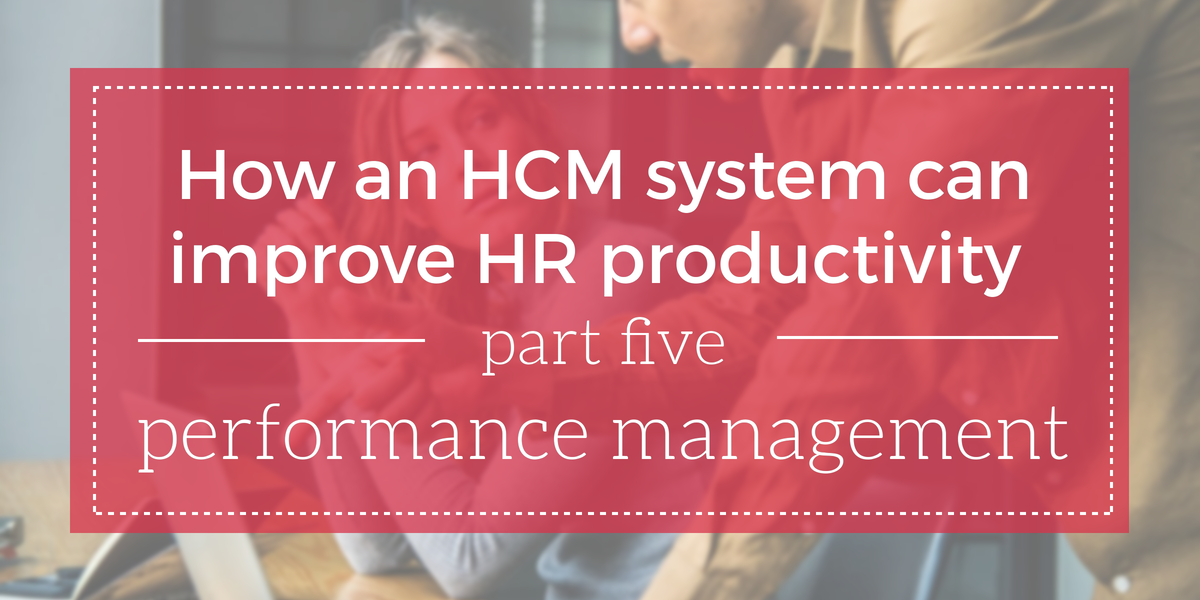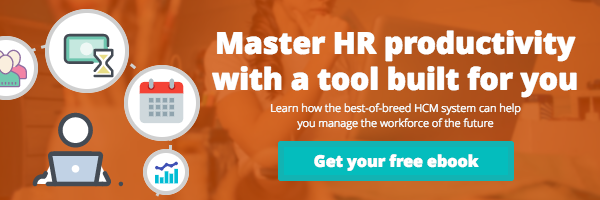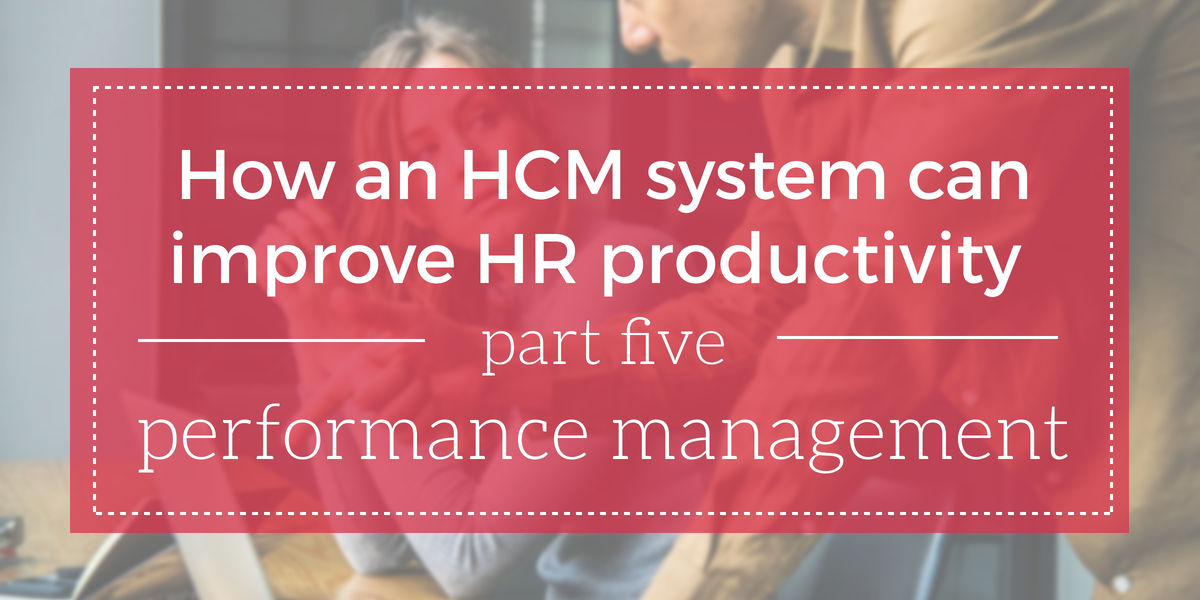
Read part 4: How an HCM system can improve productivity for HR, part four: Payroll
If you hear “performance review,” it may cause some fear and anxiety—for managers and employees alike. Many people encounter stumbling blocks when performance reviews comes around. Overworked HR managers may handle too much responsibilities with little time to guide employees in the right direction. This is where effective performance management enters the picture.
Performance management is the ongoing process of communication with employees, departments, and organizations in support of achieving the strategic goals of the organization. From planning and monitoring to reviewing and evaluating, there are many building blocks of an effective performance management strategy, including:
- Fair accomplishment-based performance standards and objectives
- Progress assessments
- Ongoing education and training
- Continuous coaching and feedback
- Effective compensation and recognition processes
- Promotional/career development opportunities
With all the elements in play, managers play a crucial role in talent management. At the same time, they should also honor employee contributions and encourage them toward professional and personal goals.
If this seems like a lot to balance, you’re not wrong. When done right, organizations gain from lower turnover and burnout, higher sales growth, better productivity, and increased customer loyalty. Poor practices, on the other hand, drag down quality relationships, neglect potential opportunities, and squander company time and money.
So how can you set your team up for success with so much to juggle? Let’s take a look at how you can drive exceptional performance using an HCM system.
Define tailored performance profiles
With a diverse and nuanced workforce in your hands, it’s important to define organization-, group- and individual-specific review profiles. It’s a mistake to assume your employees have the same goals, challenges, and competencies. The benefit of an HCM software is that it offers efficient and effective tools for capturing and sharing information to match the needs and preferences of users.
Setting clear objectives lays out the foundation for your workforce to thrive and contribute to the company’s overall success. Have specific criteria prepared for evaluation, and define competencies for individual employees and jobs. Leveraging tailored performance profiles allows the managers to document performance results and identify areas of improvement during feedback.
Encourage employees to take advantage of the Employee Self-Service feature where they’ll have instant, online access to their own information, including on-demand training, performance goals, and reviews. This can be a great starting point for a performance review conversation, as you can invite their questions, thinking, and suggestions to kickstart developmental opportunities. By giving your employees the chance to use their agency and creativity to work out solutions, managers reap the benefits of saving time and money.
Automate the performance review cycle
Automating the performance review cycle lessens the workload on your back by handling routine or repetitive tasks. But it’s also easy to depend on its functions and fall short on developing meaningful interactions. It’s wise to use automation within a structured framework that serves the mission and goals of the company so HR managers can do work that matters. Integrating automation within your systems can also help define what valuable or meaningful work might look like for employees and breed innovation without losing productivity.
Start by configuring workflows to match your organization’s processes. A manager’s job description never stays static, but that doesn’t mean they always have to rush to the next chore on the agenda. Stay on top of assessments by defining the timeline and frequency of performance reviews. By using automated alerts and reminders, managers can keep up with form completions, feedback, and approvals without missing a beat. Between managing, training and reporting, real-time monitoring helps HR professionals track progress for timely employee reviews.
Manage employee development and succession planning
Managing top talent to become superstars in their field is not an easy job. Not only do managers need to consider an employee’s job performance, but also personal and career development as well. How can you get excellent performance out of the team and take an employee’s existing skills to further heights in their role? Managing this process for individuals can take more time and thought than a one-size-fits-all development plan.
The best managers harness employee strengths, interests, and passions to create greater value for the company. Articulating goals that are practical and aspirational gives employees the opportunity to show you their best work and gets the company closer to its larger strategic purpose. After setting appropriate goals, track employee skills and certifications with customized reports that indicate who needs help and when.
By using succession planning tools in a robust software, HR managers can define training courses, assign employees, and track completion. Ensure accountability when you have visibility scheduling internal classes, monitor open seats, and report on employee participation.
With a comprehensive view of performance metrics, you have a simple, intuitive way of working with information to award employees who step up to the plate or identify pain points for a performance improvement plan.
Foster engagement and retention with ongoing feedback
Committing to honest and constructive feedback is one of the best ways to foster engagement and retention in the workplace. To really improve performance, employees need ongoing, continuous progress to build and keep momentum—not just on an annual or quarterly basis. While a manager’s job entails supporting and motivating employees, it may take a whole workday to plan a productive meeting. This isn’t anything you want to rush. Giving thoughtful and valuable input requires craft and grace. Even the most prepared manager may encounter hiccups with conversation etiquette and awkwardness.
With the right tools and information, managers are well-equipped with immediate visibility of goal status and individual employee reviews throughout the year. A single, cloud-based database ensures that managers, stakeholders, and employees can collaborate on evaluations and goals, review performance history, and monitor the overall process. Moving away from an isolated approach to a holistic, continuous process allows a well-versed manager to provide fair feedback during crucial periods.
Ongoing performance reviews can be difficult as it requires more effort from managers and supervisors. But using an HCM system to consistently follow up and improve performance feedback allows involved parties to move forward on the same page quickly and efficiently.
Connecting the dots with the right solution
The best managers know they are an employee’s key supporter, coach, and critic. Communicating thoughtful feedback and meaningful conversations consistently shapes a positive employee experience and outlook, which can be felt through the company—even down to the customer level. It’s well worth the effort to invest in proper talent development through a successful performance management process. Keeping a pulse on technological solutions offered by an HCM system can offload the weight of performance management. By using Fuse’s powerful, cloud-based, multi-faceted platform, you’ll build a sustainable performance process experience where employee culture and career flourish in unison.
Read part 6: How an HCM system can improve productivity for HR, part six: benefits management, where we’ll look at how to master benefit enrollment with the right tools.
Ready to learn how Fuse Workforce can make you and your team more productive? Talk to an HR specialist about smarter solutions for your organization.
